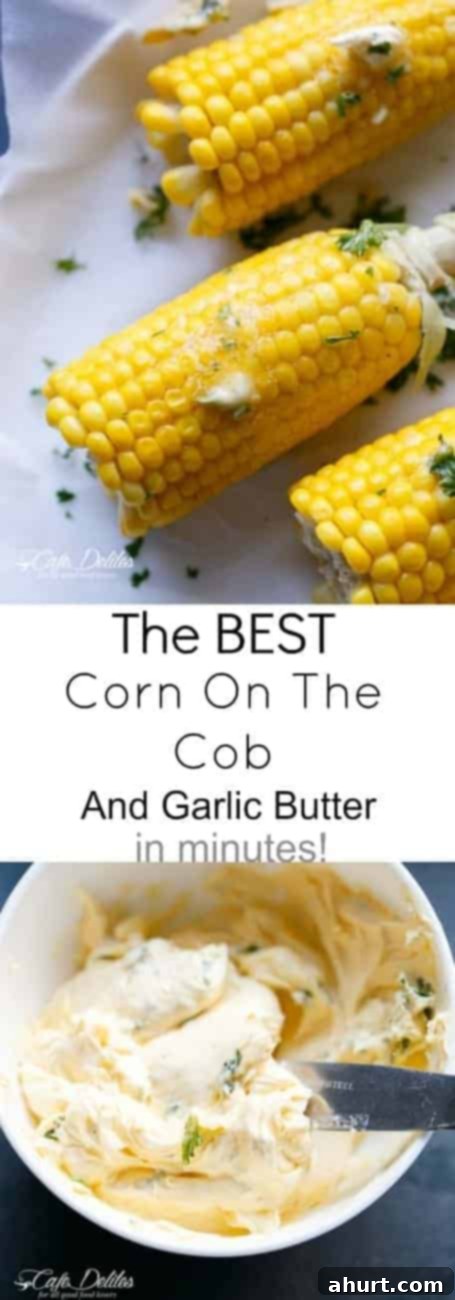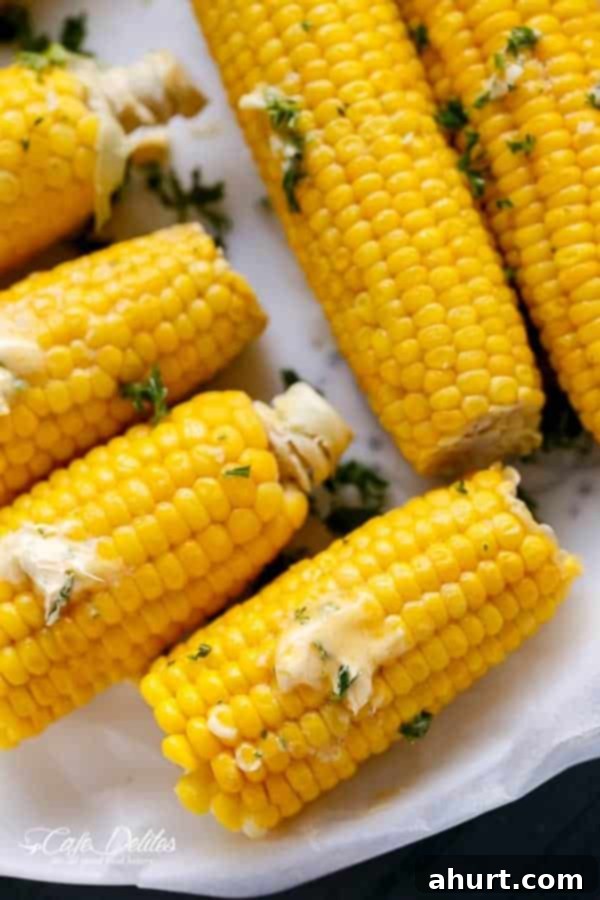The Ultimate Guide to The Best Corn On The Cob With Garlic Butter: The Secret to Sweet, Juicy Kernels
There’s simply no denying that a perfectly cooked ear of corn on the cob is one of life’s simple pleasures. It’s a side dish that transcends seasons, bringing a comforting warmth to cooler months and a fresh burst of flavor to summer barbecues. But not all corn on the cob is created equal. We’re here to share the ultimate recipe for The Best Corn On The Cob With Garlic Butter, guaranteed to elevate your dining experience. Why is it the best, you ask? Because each kernel is unbelievably juicy, supremely sweet, and practically bursts in your mouth with every bite, creating an unforgettable sensory delight.
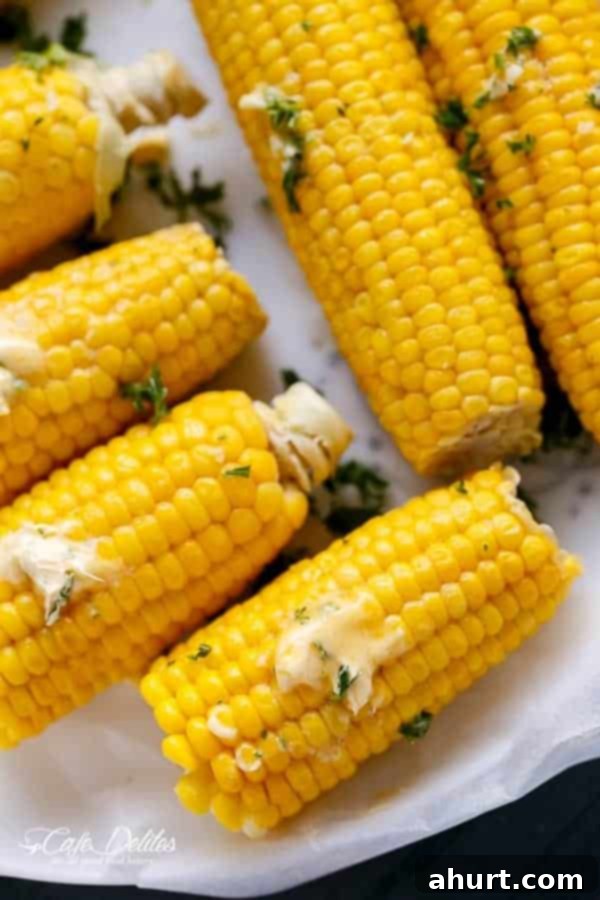
The magic doesn’t stop at the corn itself. Imagine generously slathering your freshly cooked, vibrant yellow corn with a rich, aromatic garlic butter. As it melts, coating every plump kernel in a savory, herbaceous sheen, you’ll witness a transformation from a simple vegetable to a truly decadent experience. This combination of sweet corn and savory garlic butter is more than just a side dish; it’s pure comfort food at its finest, a dish that will have everyone reaching for seconds.
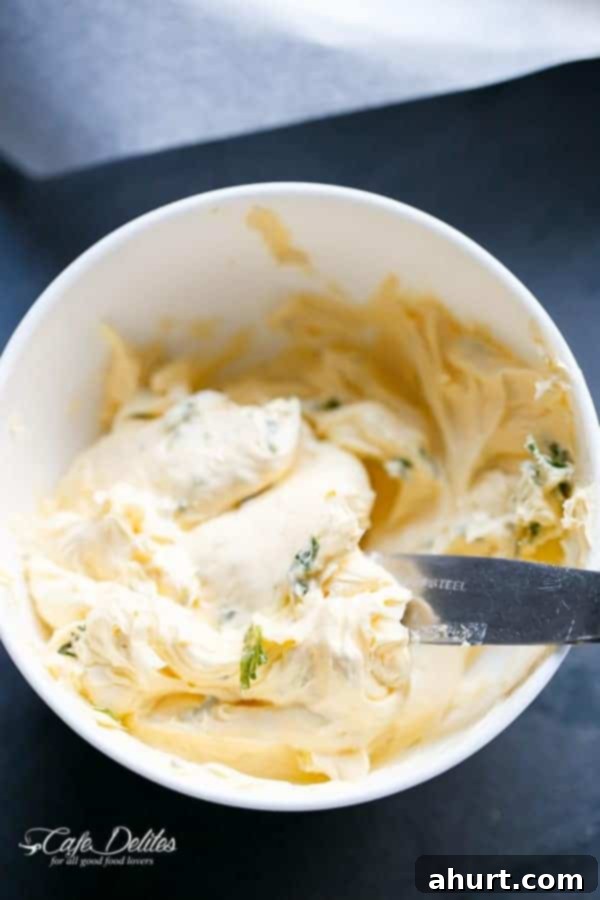
The Secret to Unrivaled Sweetness and Juiciness: Boiling in Milk
So, what exactly is the secret ingredient behind the sweetest, juiciest, and most tender corn you’ll ever have? Prepare to be amazed: it’s simply **milk**. For years, boiling corn in a combination of milk and water has been our go-to method, consistently outperforming every other technique we’ve tried. We’ve experimented with grilling, barbecuing, and traditional boiling in plain water, but none come close to achieving the incredible, bursting sweetness and tender texture that this milk-infused method delivers.
Forget adding extra sugar, butter, or cream directly to the cooking liquid. This recipe achieves its phenomenal results with just the right balance of milk and water, along with a touch of salt. The milk gently coaxes out the corn’s natural sugars, enhancing its sweetness without the need for artificial additives. It also contributes to a creamier texture, ensuring each kernel is incredibly tender and moist. This simple technique is truly a game-changer and will forever alter how you prepare corn on the cob.
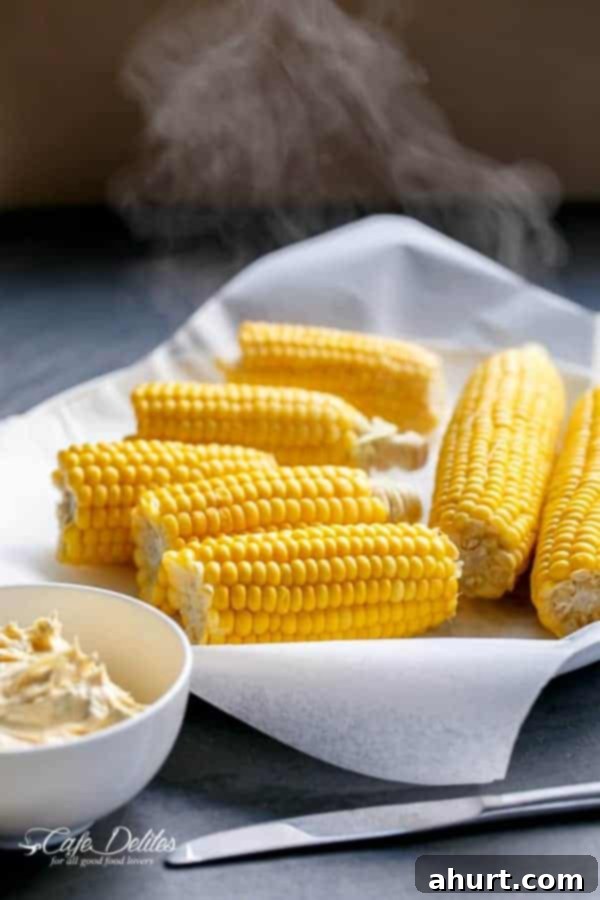
Why Milk Makes All the Difference
The science behind this simple trick is fascinating. Milk contains lactose, a natural sugar, which gently infuses into the corn, subtly enhancing its inherent sweetness. More importantly, the fat and proteins in milk contribute to a softer, more tender kernel structure, preventing the corn from becoming tough or chewy, a common pitfall with plain water boiling. The combination creates a uniquely creamy and succulent texture that truly makes this recipe stand out. The addition of salt in the cooking liquid is crucial, not just for seasoning, but for firming up the kernels just enough to give them that satisfying “burst” with every bite, without compromising their tenderness.
Selecting the Freshest Corn for the Best Results
While our milk boiling method works wonders, starting with fresh, high-quality corn is always key. When choosing corn at the market, look for:
- Bright Green Husks: The husks should be tightly wrapped around the cob, vibrant green, and not dry or yellowing.
- Damp Silks: The silks (the strands at the top) should be slightly damp and sticky, varying in color from golden to brown. Avoid dry, brittle, or black silks.
- Plump Kernels: Gently peel back a small section of the husk to peek at the kernels. They should be plump, tightly packed, and milky when pricked with a fingernail. Avoid cobs with shriveled or sparse kernels.
- Firm Feel: The cob should feel firm and heavy for its size.
The fresher the corn, the sweeter it will naturally be, providing the perfect canvas for our milk-boiling technique.
Crafting the Irresistible Garlic Butter
While the milk-boiled corn is a star on its own, the homemade garlic butter takes it to an entirely new level. This isn’t just melted butter; it’s a fragrant concoction that complements the corn’s natural sweetness beautifully. Our recipe calls for a simple yet potent mix:
- Butter of Choice: You can use full-fat butter for richness or a reduced-fat spread if you prefer. Both work wonderfully.
- Fresh Garlic: Crushed fresh garlic is highly recommended for its pungent aroma and robust flavor. If you’re short on time, garlic powder is a decent substitute, but fresh offers superior taste.
- Fresh Parsley: Finely chopped fresh parsley adds a touch of vibrant color and a fresh, herbaceous note that brightens the entire flavor profile.
- A Pinch of Salt: To enhance all the flavors and balance the richness.
The key is to combine these ingredients thoroughly, allowing the flavors to meld before slathering it onto the hot corn. The warmth of the corn will melt the butter, releasing its aromatic goodness and coating every kernel in a luxurious, garlicky embrace.
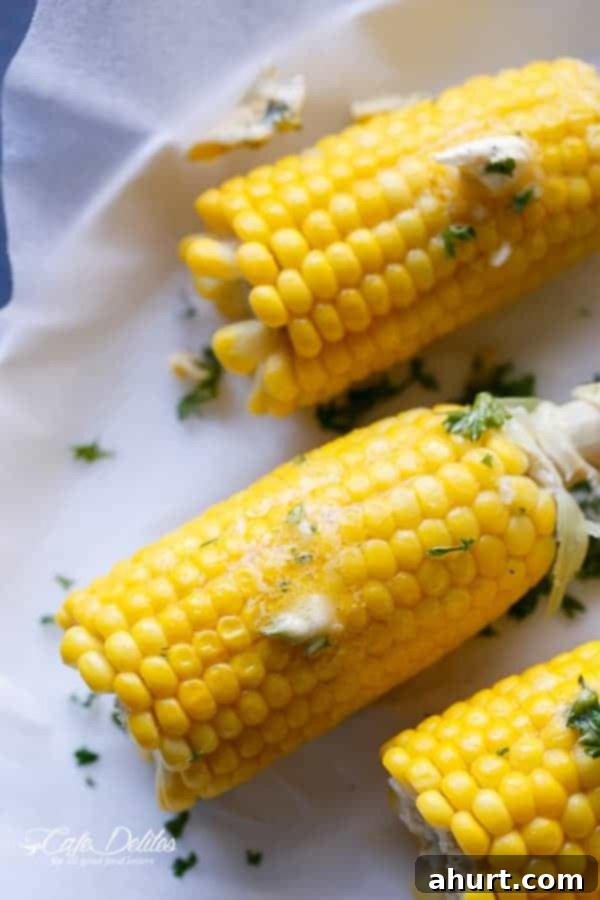
Serving Suggestions and Perfect Pairings
This incredible garlic butter corn on the cob is versatile enough to be the star of any meal. It’s the perfect accompaniment to almost any main course, whether you’re planning a casual weeknight dinner or a festive gathering. Here are some ideas for perfect pairings:
- Summer Barbecues: A natural fit with grilled chicken, steak, ribs, or burgers. Its freshness cuts through rich, smoky flavors.
- Roast Dinners: Complements roasted chicken, pork, or beef, adding a touch of sweetness and vibrant color.
- Seafood: Pairs beautifully with grilled fish, shrimp, or crab legs, especially with the garlic butter.
- Vegetarian Meals: A fantastic standalone vegetarian side, or served alongside black bean burgers, grilled halloumi, or a hearty salad.
- Holiday Spreads: A unique and delicious alternative or addition to traditional holiday sides.
And let’s be honest, sometimes this corn is so good, it could be the main event! Who cares? Corn for dinner is always a good thing, especially when it’s this delicious.
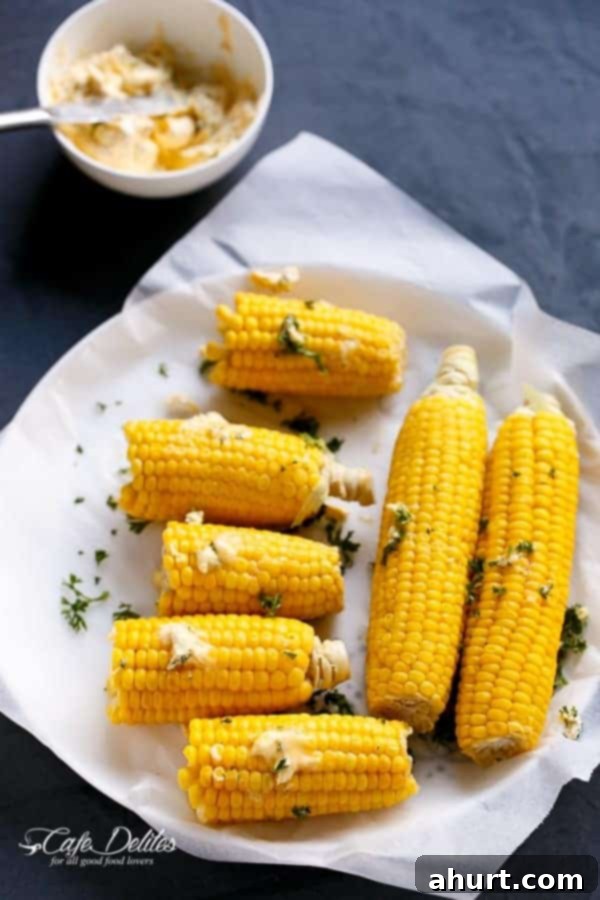
Tips for Customization and Flavor Variations
While the classic garlic butter is divine, feel free to get creative with your toppings and seasonings:
- Spicy Kick: Add a pinch of chili powder, cayenne pepper, or a dash of hot sauce to your garlic butter for a fiery twist.
- Herbal Infusion: Experiment with other fresh herbs like chives, cilantro, or dill mixed into the butter.
- Cheesy Goodness: A sprinkle of grated Parmesan or Cotija cheese over the hot, buttered corn adds an extra layer of savory flavor.
- Lime or Lemon Zest: A squeeze of fresh lime or lemon juice, or a bit of zest, can add a bright, zesty counterpoint to the sweetness.
- Smoky Flavor: A hint of smoked paprika in the butter can evoke a barbecue feel without the grill.
Storage and Reheating
If you happen to have any leftover garlic butter corn (a rare occurrence, we know!), you can store it in an airtight container in the refrigerator for up to 3-4 days. To reheat, you can:
- Microwave: A quick zap for 1-2 minutes until heated through.
- Oven: Wrap in foil and bake at 350°F (175°C) for about 10-15 minutes.
- Skillet: Sauté in a lightly oiled pan for a few minutes until warm, turning occasionally.
While freshly made is always best, this corn reheats surprisingly well, maintaining much of its juiciness and flavor.
Frequently Asked Questions (FAQs)
Here are answers to some common questions about making corn on the cob:
Can I use frozen corn on the cob?
Yes, you can use frozen corn on the cob. The cooking time might be slightly shorter since it’s typically blanched before freezing. Follow the same milk-boiling method, reducing the simmer time by a couple of minutes if needed.
What kind of milk should I use?
Any milk will work! Whole milk will give the richest flavor, but 2%, 1%, or even unsweetened plant-based milk (like almond or oat milk) can be used. The goal is the gentle infusion of flavor and tenderization, which all types of milk provide.
How do I know when the corn is perfectly cooked?
The corn is done when the kernels are just tender. You can test this by carefully removing a kernel with tongs and piercing it with a fork. It should offer slight resistance and a satisfying “burst” but not be mushy. The cooking time (5-8 minutes) is a guideline; freshness and size of the cob can affect it.
Can I make the garlic butter ahead of time?
Absolutely! You can prepare the garlic butter mixture in advance and store it in an airtight container in the refrigerator for up to a week. This makes meal prep even quicker when you’re ready to serve your corn.
Is this recipe suitable for dietary restrictions?
The main recipe contains dairy. For a dairy-free version, use unsweetened plant-based milk for boiling and a plant-based butter alternative for the garlic butter. Always check ingredient labels for specific dietary needs.
For more delicious corn dishes, be sure to check out these other favorites:
- Chicken Corn Chowder
- Corn Casserole
- Shrimp and Mexican Corn Foil Packets
- Cornbread Recipe
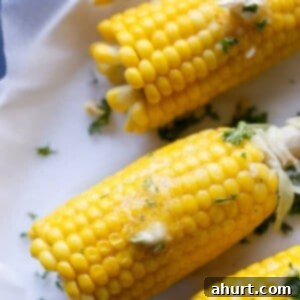
Pin
The Best Corn On The Cob With Garlic Butter
Ingredients
- 4 ears fresh corn husks and silks removed
- 4 cups milk of choice
- 2 cups water or enough to cover the corn completely
- 1 tablespoon salt about 1 tablespoon
Garlic Butter: *See Notes
- 1/2 cup butter/spread of choice I use reduced fat/light
- 1 clove garlic, crushed or 1 teaspoon garlic powder
- 2 tablespoons fresh chopped parsley
- 1 pinch salt to taste
Instructions
-
Combine the corn, milk, water and salt together in a large saucepan/pot and bring to the boil. When the milk begins to rise, reduce heat down to low and remove from the pot from the heat if necessary to allow the milk to fall if rising to rapidly. Return to low heat and gently simmer until the corn kernels are just tender (about 5-8 minutes) — (I always remove one out of the water with tongs to test with a fork. You can ‘feel’ the burst when piercing the fork through). Leave them in longer until they ‘burst’ with a fork.
-
Remove each cob with tongs and serve with butter…or serve plain!
Garlic Butter:
-
Add all ingredients into a small serving bowl, and mix until combined.
Notes
Nutrition
Nutrition information is automatically calculated, so should only be used as an approximation.
